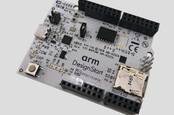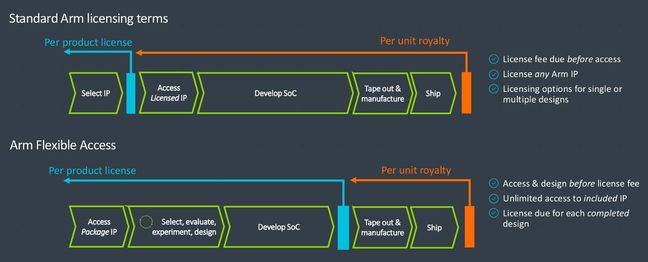This article is more than 1 year old
Dear chip designers: It will no longer cost you an Arm and a leg to use these CPU cores (well, not at first, anyway...)
Take a RISC, not a RISC-V, with us, says Softbank's processor design house
Attention, chip designers. If you want to add CPU and GPU cores, and other technology, from Arm to your homegrown silicon, and have balked at the upfront costs, this may be of interest.
The processor design house wants to lower the barrier to entry by delaying demands for licensing payments until the moment you reach tape-out. There are caveats, which we'll get to.
There are a few ways to get hold of Arm cores on the cheap, but those CPUs tend to be rather low-end. That aside, up until now, engineers wanting to use Arm's blueprints typically have to leaf through the Softbank-owned biz's catalog of intellectual property, pick out the pieces they want, and then pick up the phone to a salesperson.
Once a licensing agreement is reached and payment is coughed up, the engineers get a copy of the blueprints they wanted from Arm, and can start designing their own silicon around these building blocks. When the system-on-chip is manufactured, Arm collects a royalty on each component shipped.
These upfront licensing costs can be off-putting for startups as well as larger organizations dabbling with the idea of designing their own custom silicon. You have to obtain and then spend a bunch of money on fees for a project that may or may not make it to fabrication. You may have to revise your choice of licensed designs – such as selecting a beefier Arm CPU – which you may have to pay for all over again.
What's new?
For established Arm licensees, the above isn't much of a problem: they've been around the block long enough to know what they want, how to get it, how much it costs, and how to bring it to market. There isn't a whole lot of risk. For those entering the semiconductor market, it can be a pain.
As such, Arm will today unveil what it calls Arm Flexible Access.
This program basically allows you to defer license payments, and go straight to picking the intellectual property you want from Arm's catalog, getting the material, designing and simulating and evaluating your system-on-chip design, and swapping out building blocks for alternative Arm technology as needed as you go.
When you come to tape-out – industry jargon for sending off your completed blueprints to chip factories to fabricate the things – you pay Arm the licensing fees owed, and then pay royalties on shipments as usual.
The diagram below, provided by Arm, neatly illustrates how payments are deferred. Arm will still get its pound of flesh from you – this isn't inherently a discount offer – it just means you'll cough up the dosh a little later than before, which may suit you if you're a startup or if you're drawing up custom semiconductors for the first time:
"Overall it is pricing-neutral, with no significant changes to pricing planned," an Arm spokesperson told The Register, referring to the deferred licensing fees.
"In some partner cases it could lower their costs, particularly when combining different Arm IP within the same SoC. By removing the initial license fees to access the massive amount of Arm technology included in Flexible Access, Arm is making a significant investment in its partners by allowing them to design freely and pay only for the IP they use at tapeout. If they are successful, then Arm is successful."
There are a couple of caveats. One, we've learned, is that to enter the Flexible Access will cost $75,000 per year with one annual tape-out, or $200,000 per year with unlimited tape-outs. The second caveat is that Flexible Access only covers some of Arm's family of cores and related designs: the family jewels, such as top-end Cortex-A CPUs, aren't in there.
For example, the 2012-era Cortex-A53 is the most powerful A-series on the list. Then there's the earlier A35, A34, A32, A7, and A5. There are three from the Cortex-R family – R52, R8, and R5 – and a bunch of microcontroller-grade Cortex-M cores, from the M0 to the M33. There are also G31 and G52 Mali CPUs, various interconnects (like the CoreLink NIC-450), Trustzone blocks, hardware controllers, and so on. The full list, and a comparison between Flexible Access and Arm's usual licensing approach, should be here by the time you read this.
Essentially, Flexible Access contains the ingredients you need to, say, build a modest system-on-chip, or add some general-purpose application cores to your specialist homegrown neural-network accelerator, or some glue CPU compute to your workload-specific ASIC. Arm envisions people using Flexible Access to produce components for drones, medical systems and industrial control, network-connected cameras and sensors, smart home stuff like smart locks, and more of that sort of thing.
These ingredients are not going to be enough to make a processor for the next top-end smartphone, or slabtop: you'll have to join the big kids in the normal Arm licensing model for that. Flexible Access will also open the door to all the stuff Arm is well known for: its technical support, tooling, and fast cycle-accurate simulators that making crafting a system-on-chip less of a pain.
Why? Part I
There are two possible reasons why Arm is doing this. One is that RISC-V, a fledgling rival technology that Arm CEO Simon Segars last year said is keeping his engineers and salespeople on their toes, keeps growing with continued interest from Google, Western Digital, Nvidia, and others.
At its heart, RISC-V is a set of open-source specifications: they define how software can be written to use RISC-V processors, and leaves the actual implementation of the CPUs and system-on-chips to whoever wants to design one. Many of these blueprints are publicly available under commercial and open-source licenses, though.
So people can, at least in some cases, grab the Verilog or Chisel code for RISC-V cores and system-on-chips off the shelf and start evaluating them with no major, if any, upfront costs. They have to pay up when they want to fabricate the components, of course, and also pay for any additional intellectual property they licensed along the way to fill out and complete their design.
This is quite possibly why Arm is now offering Flexible Access: to hopefully head off those mulling using no-money-down freely available, or reasonably licensed, implementations of RISC-V: a 32-bit, 64-bit, and 128-bit instruction set architecture that is similar to 64-bit Armv8, which is similar to MIPS64.
SiFive, for one, will allow you to customize a RISC-V CPU in your web browser, and download the resulting design either for free as soon as it's generated, or after agreeing to a license, to evaluate in an FPGA. You only start paying SiFive once you begin manufacturing your chip: there are no upfront costs.
And SiFive's most powerful Linux-booting 64-bit RISC-V cores are, in terms of performance, said to compare to... Arm's Cortex-A50-series, the highest available from Arm's Flexible Access, funnily enough. You can see where this is all going.
SiFive and others improve their RISC-V cores, Arm opens up access to its intellectual property a little more, and so on. As the RISC-V world expands its cores from microcontroller-level and low-to-mid-end Cortex-A-grade offerings to more and more capable CPUs, Arm will ease up on the licensing of more and more of its overall portfolio. It looks like a cat and mouse game.
Why? Part II
On the other hand, the arrival of RISC-V and Flexible Access could possibly be a big coincidence. One Arm executive told us on Friday: "We were going to do this anyway."
This is because more and more organizations, from startups to tech manufacturers and computer makers to cloud giants, are designing, or want to design, customized silicon to process specific workloads, from AI and computer vision to security filters and data storage management.
Once they've come up with a neat way to accelerate particular operations in hardware, they still need to stick interconnects and other building blocks around it all to glue it to the host system, and they may want to throw in some CPU cores to execute code that controls the thing directly. To help people produce this kind of chippery, Arm hopes to lower the barrier and entice them into picking from its portfolio.
Arm claimed "75 percent of all Cortex CPU licenses signed over the last two years" are included in the Flexible Access program. In other words, who gives a flying flip-flop about RISC-V and SiFive; this Flexible Access portfolio is good enough for our upfront-fee-paying customers.
Dipti Vachani, senior vice-president and general manager of Arm’s automotive and IoT business, has some more words on today's announcement here, if you're interested. ®
In other semiconductor news...
- Intel is offering boffins an up-to-64-chip research-grade device capable, it is claimed, of simulating an eight-million-neuron neuromorphic system. The kit is codenamed Pohoiki Beach, and the individual chips Loihi.
"With the introduction of Pohoiki Beach, researchers can now efficiently scale up novel neural-inspired algorithms — such as sparse coding, simultaneous localization and mapping (SLAM), and path planning — that can learn and adapt based on data inputs," said Chipzilla.
- The RISC-V Foundation ratified its base and privileged architecture specifications this month, which is cool and all, though largely a formality as cores are already available in silicon following the specs.
- Qualcomm unveiled the Snapdragon 855 Plus, a faster variant of its SD 855.


